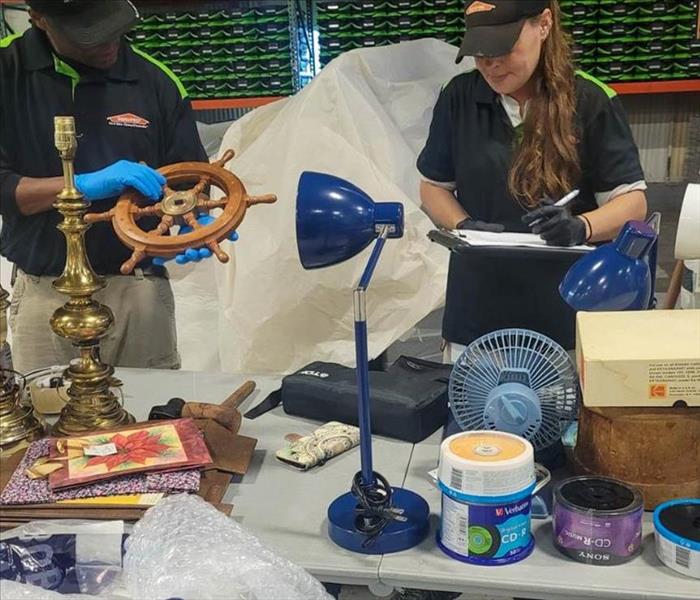Expert Cleaning Tips for Water-Damaged Upholstery
10/14/2023 (Permalink)
 it's essential to address the damage quickly to prevent permanent damage and ensure the safety and longevity of your furniture.
it's essential to address the damage quickly to prevent permanent damage and ensure the safety and longevity of your furniture.
Water-damaged upholstery can be a significant headache for homeowners. Whether it's from a leaky roof or a plumbing issue, water damage can leave your furniture sopping wet, dirty, and even foul-smelling. However, it's essential to address the damage quickly to prevent permanent damage and ensure the safety and longevity of your furniture.
In this post, we will share expert tips on how to clean water-damaged upholstery for safety and longevity. Follow these techniques to restore your upholstery to its pre-damaged condition and maintain its lifespan.
Assessing the Damage
Before starting the cleaning process, it is essential to evaluate the extent of the damage and identify potential issues.
- Take an inventory of the affected furniture, making a note of the material, age, and condition.
- Look for signs of mold growth, as damp upholstery is an ideal environment for mold to grow.
- Check for any signs of structural damage or instability, such as softened, warped, or broken wood frames.
- Once you have assessed the damage, you'll have a better idea of how to proceed with the cleaning process.
Cleaning Methods
Cleaning water-damaged upholstery requires careful attention to detail and particular cleaning techniques. Here are some tips to get you started:
- Removing Excess Water
The first step is to remove any water from the upholstery to prevent further damage. Here's how to do it:
- Use a wet-dry vacuum to extract large amounts of water.
- Place a clean, dry towel over the affected area and press down to absorb as much water as possible.
- Do not use any heat sources such as hairdryers, as this can cause shrinking and damage to the upholstery.
- Cleaning Solutions
Different types of upholstery require different types of cleaning solutions. Here are some tips to help you choose the right cleaning solution:
- For natural fabric upholstery, mix equal parts white vinegar and distilled water. Pour the solution into a spray bottle and shake well before use.
- For leather, mix a mild soap with distilled water. Avoid using solvents or harsh chemicals as they can cause permanent damage.
- For synthetic fabrics, refer to the manufacturer's instructions, as some types of fabric require specific cleaning products.
- Spot Cleaning
Once you have the right cleaning solution, it's time to spot-clean any stains or marks on the upholstery. Here's what to do:
- Spray the cleaning solution on the affected area.
- Use a clean, white towel to blot the spot, starting from the outside and working your way inwards.
- Do not rub the stain as this can spread it.
- Deep Cleaning
After spot cleaning, it's time to deep clean the upholstery. Here's what to do:
- Spray the cleaning solution over the entire piece of furniture, including the cushions, armrests, and backrest.
- Use a soft-bristled brush to work the solution into the fabric, focusing on dirtier areas.
- Allow the furniture to air-dry thoroughly. Do not use a heater or fan as this can cause shrinkage or damage.
Drying Techniques
Drying your water-damaged upholstery properly is crucial to prevent further damage and mold growth. Here's what to do:
- Ensure the furniture is in a well-ventilated area with good air circulation.
- Use fans or dehumidifiers to speed up the drying process.
- If the furniture is not drying properly, consider hiring a professional who can use specialized drying equipment.
Safety Precautions
Cleaning water-damaged upholstery requires extra precautions to ensure safety. Here are some safety measures to keep in mind:
- Wear protective gear such as gloves, eye goggles, and face masks to avoid mold spores or chemicals from getting into your eyes or lungs.
- Avoid mixing cleaning chemicals as they can cause dangerous fumes.
- Keep children and pets away from the affected area until it is completely dry and safe.
Professional Cleaning Services
If the water damage is extensive or you are not confident in cleaning the furniture yourself, consider hiring professional upholstery cleaning services, such as our SERVPRO® of The Seacoast team. Our team of professionals has specialized equipment and training to clean furniture that has been damaged by water or mold safely.
Water-damaged upholstery can be a significant headache for homeowners, but it doesn't have to be. With the right cleaning techniques and maintenance tips, you can restore your furniture to its original condition and ensure its longevity. Follow these expert tips for safety and longevity, and enjoy your furniture for years to come.






 24/7 Emergency Service
24/7 Emergency Service